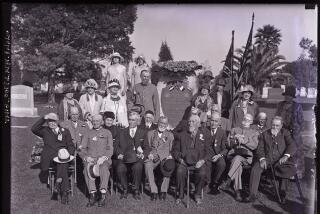Annie Snyder, 80; Fought to Preserve Manassas, Va., Battlefield and Environs
- Share via
Annie Snyder, the Virginia farmer and World War II Marine Corps veteran who led major campaigns against Marriott Corp., Walt Disney Co. and other developers in her decades-long battle to preserve land near the Manassas Civil War battlefield, has died. She was 80.
Snyder, who had diabetes and heart problems, died July 19 of pneumonia at Prince William Hospital in Manassas, Va.
For the record:
12:00 a.m. Aug. 1, 2002 For The Record
Los Angeles Times Thursday August 01, 2002 Home Edition Main News Part A Page 2 National Desk 10 inches; 381 words Type of Material: Correction
Preservation trust--A Saturday obituary of Annie Snyder, the Virginia farmer who battled to preserve the Manassas Civil War battlefield and nearby land, misstated the name of the National Trust for Historic Preservation.
*
A conservative Republican, Snyder began leading political crusades in Prince William County not long after she and her airline pilot husband, Pete, moved to their 180-acre farm near Gainesville after World War II.
The farm, on which Snyder raised strawberries and Black Angus cattle, lies just east of Manassas National Battlefield Park, where Union and Confederate troops clashed in two major Civil War battles. (The Battles of Manassas were known by Northerners as the Battles of Bull Run.)
Battle of the Interstate
The first of what Snyder called her many “battles of Manassas” to preserve the historic ground began in the 1950s when she successfully fought federal highway engineers who wanted to build an interstate through the middle of the battlefield about 30 miles west of Washington.
In the ‘70s, she led a campaign that forced Marriott to abandon its proposal to build a Great America theme park on nearby land.
In the mid-’90s, she and other preservationists--most prominently the National Trust for Historic Places and historians David McCullough and Shelby Foote--worked to thwart Disney’s plans to build an American history theme park, housing, shops and hotels on 3,000 acres about four miles from the battlefield.
In surrendering, Disney executives acknowledged that the national debate over the $650-million project damaged the company’s image.
But the battle that made her an internationally known preservationist came in 1988 when the developer of a “campus-like” 540-acre residential-retail-office complex dropped a bombshell two years after receiving approval by announcing that the centerpiece of the project would be a 1.2-million-square-foot mall.
The site for the mall was Stuart’s Hill, the ridge where Confederate Gen. Robert E. Lee directed his troops to victory at the Second Battle of Manassas in 1862.
Preservationists were aghast.
“Another piece of America’s heritage is about to be taken away from us forever,” Snyder said at the time.
The media jumped on the story, their cameras capturing bulldozers and chainsaws as construction crews worked around the clock on the site.
Snyder led the charge, launching the Save the Battlefield Coalition, which grew to include more than 120 history and preservation groups. They gathered more than 80,000 petition signatures and won the backing of several congressional leaders.
Jody Powell, a descendant of nine Manassas veterans and onetime press secretary for President Carter, joined up as a tactician and spokesman.
During a congressional hearing, Powell made an impassioned speech in which he referred to that “blood-soaked piece of Virginia countryside” where “history is palpable.” As he spoke, the network news cameras focused on Snyder sitting next to him, tears streaming down her face.
In the end, Congress approved spending $120 million to buy the land and President Reagan signed the legislation, which saved the site from development.
To her foes over the decades, Snyder was “selfish,” a “crackpot,” and a “real environmental nut” who cost the county dearly in tax revenue and jobs.
“I’ve never been anti-growth,” Snyder told the Washington Post in 1984. “That’s unrealistic. What I am against is destroying natural resources that are irreplaceable in the name of growth.”
Born Elizabeth Anne Delp in Pittsburgh, Snyder was the daughter of a prosperous attorney. She entered Allegheny College at 16 and graduated with a degree in English and history at 19. She was attending law school at the University of Pittsburgh in 1943 when she dropped out to join the Marines.
‘Mollie Marine’
Among the first female officers in that branch of the armed forces, Snyder was one of five women in the Corps to serve as models for the “Mollie Marine” statue, the nation’s first monument to women in uniform.
Dedicated Nov. 10, 1943, it stands on Canal Street in New Orleans, where Snyder first worked as a recruiter before traveling around the nation seeking female recruits. She was working in the quartermaster’s office at the Marine Corps Base Quantico in Virginia when she met the Marine pilot who would become her husband.
After the war, the Snyders moved to their rural property, where Annie raised six children and ran the farm and cattle operation while her husband flew for the airlines. In her spare time, she became Prince William County’s most prominent civic activist.
The upstairs study in her home was filled with cabinets and cardboard boxes from her many battles against proposed road improvements, bond issues and developments. She also was an early fighter for civil rights and better schools.
“I have kept up on everything that goes on in this county,” she told the Washington Post in 1995.
The battles also earned her many enemies, something she viewed with pride.
“I bet I’m the only woman you know who’s going to have a bouncer at her funeral,” she once joked to a reporter. “I’ve already arranged to keep my enemies out who are going to want to come and dance on my grave.”
She added with a chuckle, “You know, friends come and go, but enemies are forever.”
Snyder is survived by her husband of 57 years; her six children; six grandchildren; and a great-grandchild.
More to Read
Sign up for Essential California
The most important California stories and recommendations in your inbox every morning.
You may occasionally receive promotional content from the Los Angeles Times.










